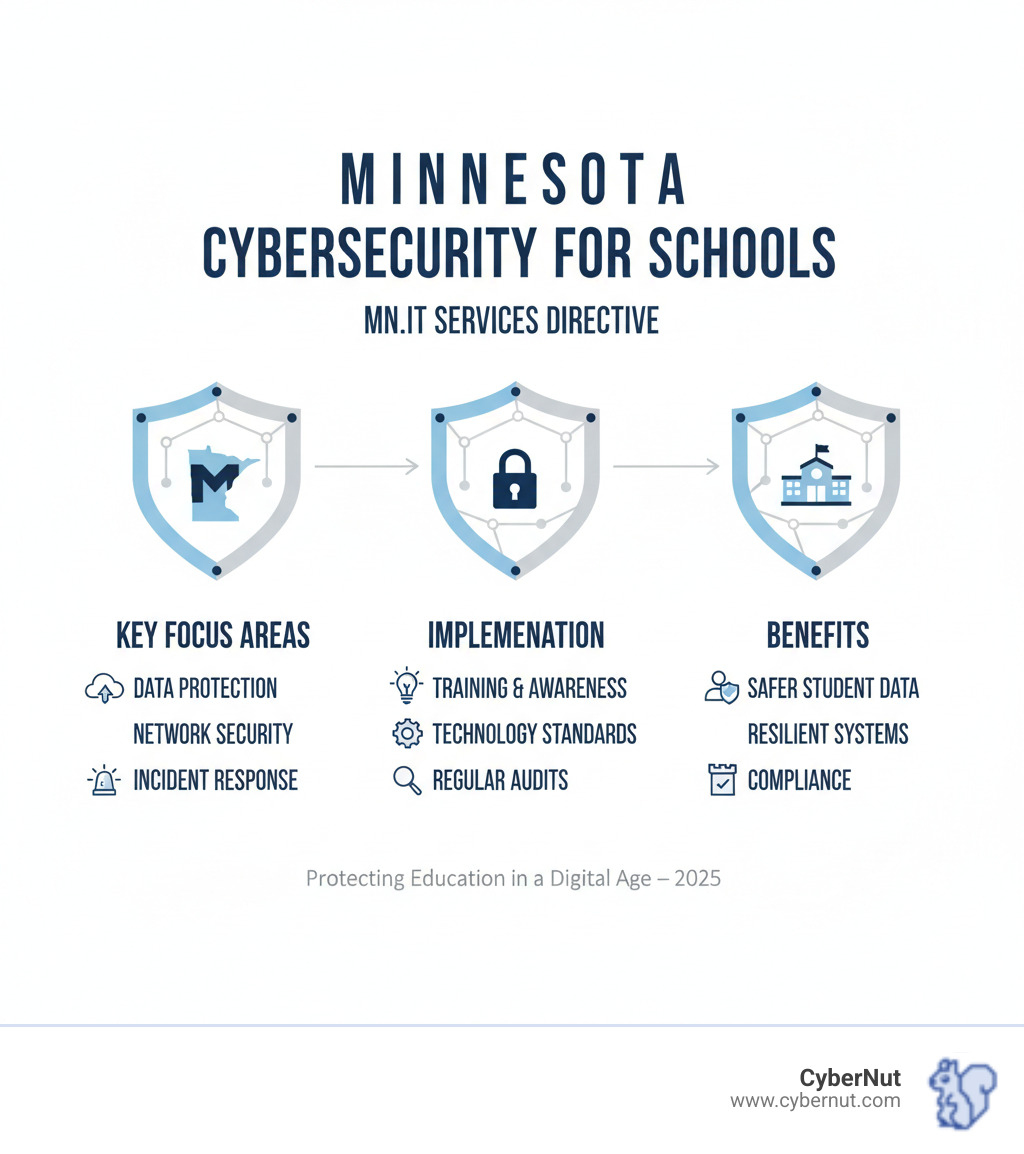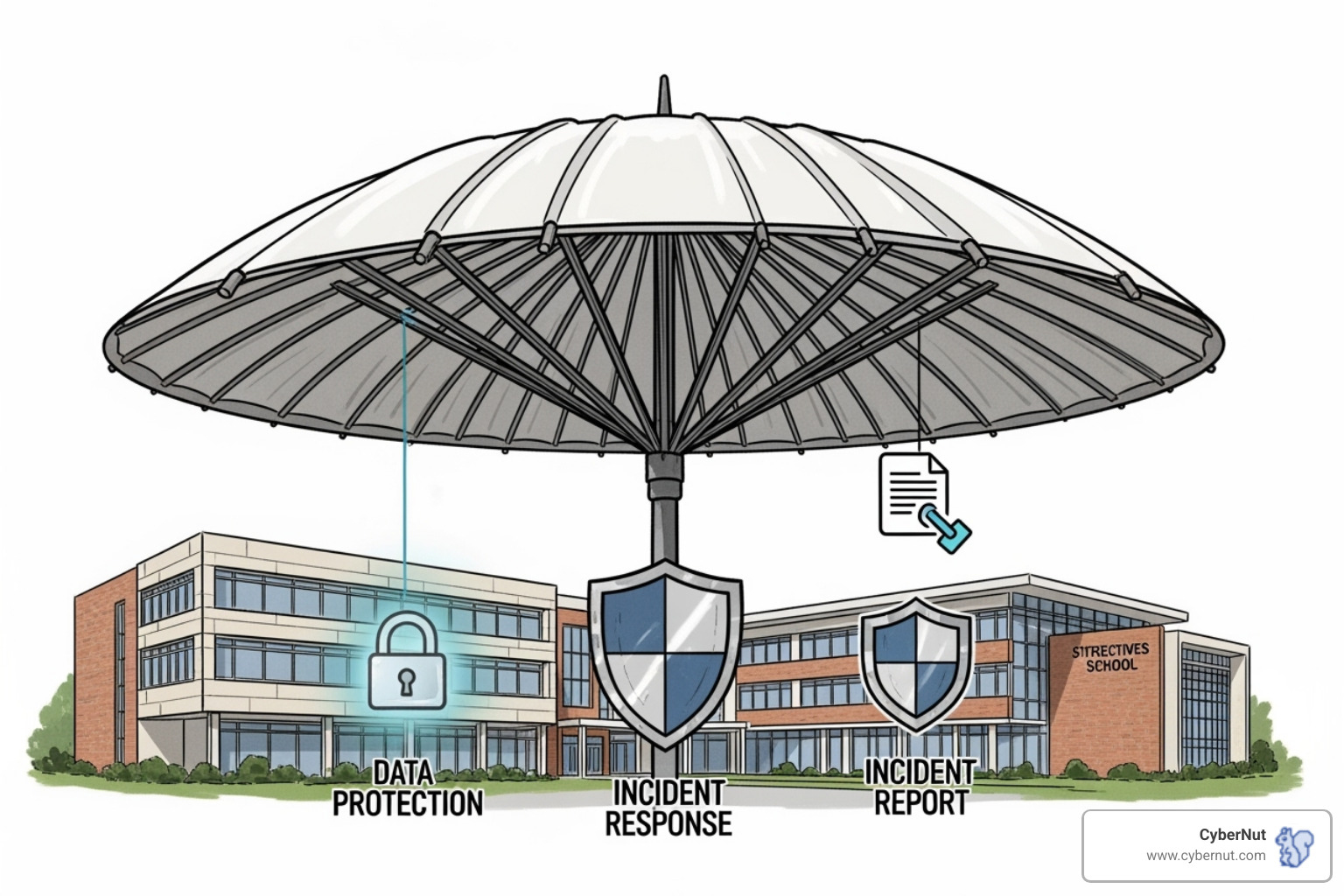
Oliver Page
Case study
October 25, 2025

Minnesota's Cybersecurity Directive for Schools (MN.IT Services Guidelines) requires K-12 districts to create incident response plans, protect student data under privacy laws, and work with state agencies to defend against cyber threats.
Quick Overview: What Minnesota Schools Need to Know
Cybercriminals are increasingly targeting schools. In May 2023, the MOVEit data breach exposed sensitive information for about 95,000 students in foster care and hundreds more across various districts. This event served as a major wake-up call, highlighting the vulnerability of educational systems.
In response, Minnesota established a unified defense strategy through its cybersecurity framework, including Executive Order 22-20 and the MN.IT Services Guidelines. This framework extends from state agencies to individual school districts.
However, compliance is more than a checklist; it's about actively protecting students, staff, and your district's reputation. With mandatory incident reporting now in effect, the question is not if an attack will happen, but if you are ready.
Fortunately, Minnesota provides a support system with funding, shared security tools, and clear guidelines. This guide will help you steer these requirements and build a resilient defense, starting with your most important asset: your people.

Navigating state directives can feel daunting, but Minnesota's Cybersecurity Directive for Schools (MN.IT Services Guidelines) is a straightforward playbook for your district.
Its primary purpose is to establish minimum requirements for how schools respond to a cyber incident. The goal is to control damage, protect data, and maintain school operations with minimal disruption. These guidelines apply to all K-12 public school districts, charter schools, intermediate districts, and cooperative units.
Your key responsibilities are to:
Resilient districts go beyond response plans and take proactive measures like implementing multi-factor authentication, managing vulnerabilities, and conducting regular security awareness training. Your staff is your first line of defense. Learn more about building a comprehensive strategy in our guide on the Data Security and Privacy Plan.

Cybersecurity and data privacy are two sides of the same coin. The Minnesota Government Data Practices Act (MGDPA) is the state-level foundation. While it presumes government data is public, it allows sensitive security information to remain confidential during investigations to avoid tipping off attackers. You can find the full statute on the Minnesota Government Data Practices Act website.
The Family Educational Rights and Privacy Act (FERPA) is the federal law protecting student education records since 1974. It governs how Personally Identifiable Information (PII) is handled, and the MN.IT Services Guidelines align directly with its requirements. For a deeper dive, read our article: All About FERPA: The Federal Student Privacy Law That Still Matters in 2025.
Additionally, Minnesota's HF 2353 targets student data privacy by requiring Data Privacy Agreements (DPAs) with vendors and mandating public notification about data practices, increasing transparency.
Understanding these terms is crucial for compliance:
Using these terms correctly ensures clear communication with state agencies during a crisis. For a complete list, bookmark the MN.IT Services Glossary of terms.
Wondering where your district stands on cybersecurity awareness? Request a complimentary phishing audit to see how your staff would respond to real-world threats.
Even with strong defenses, incidents can happen. Being prepared is key, and your Incident Response Plan (IRP) is your guide for when things go wrong.
An information security incident is any event that poses a significant threat to your technology or data. This includes unauthorized access, the loss of not public data (like student records), or the use of your systems for criminal activity. A ransomware attack or a successful phishing attempt are clear examples.
A robust IRP guides your team through every phase of an incident:
For more K-12 specific guidance, see our post on Incident Response Planning in K12. The NIST 800-61 Computer Security Incident Handling Guide is another excellent resource.

Your incident response team should have clearly defined roles, including an Incident Handler to coordinate the effort, Technical Contacts, Legal Counsel, Information Security, and Public Affairs. For serious incidents, you may also need Forensics experts and Law Enforcement.
During an investigation, all information is considered sensitive under the MGDPA. Operate on a need-to-know basis and label documentation appropriately. This confidentiality is vital to protect the investigation and avoid tipping off attackers.
A plan that has never been tested is unreliable. Minnesota's Cybersecurity Directive for Schools (MN.IT Services Guidelines) requires annual testing of your IRP for this reason. You must conduct exercises, like tabletop simulations, at least once a year to ensure your team knows their roles and the plan is effective.
Testing should also validate your plan against external processes. Does it coordinate with local law enforcement or third-party vendors? These relationships must be tested before a crisis.
After each test, review the results to identify weaknesses and make improvements. This feedback loop is vital for strengthening your response capabilities. Think of it as a fire drill for cybersecurity—the more you practice, the more effective your team will be during a real emergency.
Want to know how vulnerable your district is to the most common attack vector? A complimentary phishing audit can reveal gaps in your human firewall. The best incident response is the one you never have to use.
Waiting for an attack to happen is not a smart strategy. Minnesota's Cybersecurity Directive for Schools (MN.IT Services Guidelines) emphasizes proactive measures to build a resilient defense.
This approach, combined with Executive Order 22-20, creates a framework for prevention. Vulnerability management—continuously identifying and fixing weaknesses—is at its heart. MN.IT Services offers scanning and support to help districts find problems in their public-facing systems.
Third-party risk is another major concern, as highlighted by the MOVEit breach. Vendor risk management is a critical best practice to ensure your partners aren't creating backdoors to your data.
However, your most powerful security tool is your people. Security awareness training is a core requirement because every staff member can be either a vulnerability or a defender. For more on this, see Proactive Cybersecurity: Safeguarding K-12 Schools from Emerging Threats.

Your district's biggest vulnerability is often a well-meaning staff member who clicks on a convincing phishing email. The good news is that training can turn them into your strongest defense.
Effective training is an ongoing process, not a one-time event. Phishing simulations are a powerful tool, allowing staff to practice identifying suspicious emails in a safe environment. These simulations build muscle memory for spotting real-world threats. See how your district would fare by requesting a complimentary phishing audit.
Training should begin during staff onboarding to make security part of your district's culture. It's also vital to provide student education on cyber-safety, as emphasized by the Matt Epling Safe Schools Law. As noted in Cybersecurity Training: Urgent for Educational Safety, this transforms individuals from potential targets into valuable assets. Learn more from our insights on Phishing Simulation Test.
Beyond training, you need robust technical defenses. Key proactive measures include:
Implementing these measures consistently reduces your attack surface and builds genuine resilience.
Minnesota has built an impressive support network to help schools, but this support comes with accountability. Understanding both is crucial.
Q13: What is the role of MN.IT Services and other state agencies in supporting school cybersecurity efforts?
MN.IT Services acts as the state's cybersecurity command center. Its Security Operations Center (SOC) monitors threats statewide and, since December 1, 2024, serves as the central point for mandatory incident reporting from schools. This data helps identify threat patterns and coordinate responses.
The Whole-of-State Cybersecurity Plan, backed by over $23 million in federal and state funds, provides shared security services to local governments, including schools. A significant portion of this funding is directed to local and rural entities.
The Minnesota Department of Education (MDE) supports these efforts by administering school safety grants that can be used for cybersecurity initiatives, recognizing that digital safety is fundamental to educational continuity. For more custom information, visit our Cybersecurity Insights for Minnesota School Districts page.

Q15: What are the potential consequences for schools that do not comply with these cybersecurity directives?
Non-compliance leads to severe consequences beyond bureaucratic headaches. The most immediate is increased vulnerability to attacks. This can result in devastating data breaches, damaging your district's reputation and eroding community trust. The financial fallout includes costs for notification, credit monitoring, forensic investigations, and potential lawsuits. Furthermore, non-compliance can trigger regulatory scrutiny from state and federal authorities, leading to time-consuming investigations. Attacks like ransomware can cause massive operational disruption, canceling school and leading to the permanent loss of critical information. The cost of non-compliance far exceeds the investment in getting it right.
Q10: What are the implications of the MOVEit data breach on Minnesota schools?
The May 2023 MOVEit breach was a stark wake-up call. A vulnerability in a widely used third-party file transfer tool exposed the data of nearly 95,000 students in foster care and hundreds more in various districts. The key lesson: your security is only as strong as your weakest vendor. This event underscores why the state guidelines emphasize vendor risk management and the need for a practiced Incident Response Plan. You can learn more about the technical details at the MOVEit vulnerability details page.
Q11: How do recent legislative changes intersect with these cybersecurity directives?
While some laws like HF 2516 / SF 508 (addressing cell phone use) have an indirect impact by changing the digital landscape, others are directly aligned. The Matt Epling Safe Schools Law requires comprehensive cyberbullying policies and annual training for staff and students. This aligns perfectly with the proactive security awareness training in the cybersecurity directives, helping to build a "human firewall" by teaching critical thinking about online threats.
Q12: What resources or support are available to Minnesota schools?
Minnesota's "Whole-of-State" approach provides access to resources that would be too expensive for individual districts. Key opportunities include:
While Government Funding for Cybersecurity Is Inadequate -- Schools Are at Risk, Minnesota is making a genuine effort to bridge the gap. Proactively applying for these funds is key. A phishing audit can help establish your baseline needs before applying.
Protecting your district is about building a culture of security, not just checking compliance boxes. We've covered the essentials of Minnesota's Cybersecurity Directive for Schools (MN.IT Services Guidelines), from incident response planning to proactive defenses and the critical role of security awareness training.
Cyber threats are persistent, but Minnesota offers a comprehensive support system to help you succeed. The Whole-of-State Cybersecurity Plan and federal funding opportunities provide the resources; it's up to districts to use them.
The most effective defense is a human firewall—empowered people who understand their role in protecting sensitive data. When you train your staff and educate your students on digital safety, you create a resilient security culture that multiplies across your community.
The shift to proactive security is no longer optional. With mandatory incident reporting in effect, readiness is paramount. Every employee trained and every vulnerability patched strengthens your district's defenses.
At CyberNut, we understand K-12 schools. Our automated, gamified micro-trainings are designed for busy educators, turning complex security concepts into simple, actionable habits that stick.
Ready to strengthen your district's cybersecurity posture? Start by understanding your current vulnerabilities. Request a complimentary phishing audit to see how your staff would respond to real-world threats.
For more tools and insights to help your district steer Minnesota's cybersecurity requirements, explore our Resources hub. Together, we can build a safer learning environment for your students and staff.

Oliver Page

Some more Insigths


Back